In this article, we are going to take you through the best Blue Chip stocks to buy right now. First, let’s clarify the definition of Blue Chip stocks or Blue Chip companies.
YOUR CAPITAL IS AT RISK. 76% OF RETAIL CFD ACCOUNTS LOSE MONEY.
A Blue Chip company is a company with a national or international reputation. They are generally large well-established companies that have been operating for many years and whose earnings and overall finances are stable. Think of companies such as Johnson & Johnson or Disney. Although there is no preferred index for only Blue Chip stocks, the Dow Jones Industrial Average (DJIA) is often used to measure the health of very large and well-known public stock companies. The index consists of 30 participants, and it is one of the oldest equity indexes followed by the investment community. Each company in it is large, but weightings follow a percentage allotment formula.
It is not a gauge of the entire economy, but it does reflect on how Blue Chips are performing. Here is a recent chart depicting the history over the past two years on a weekly basis:
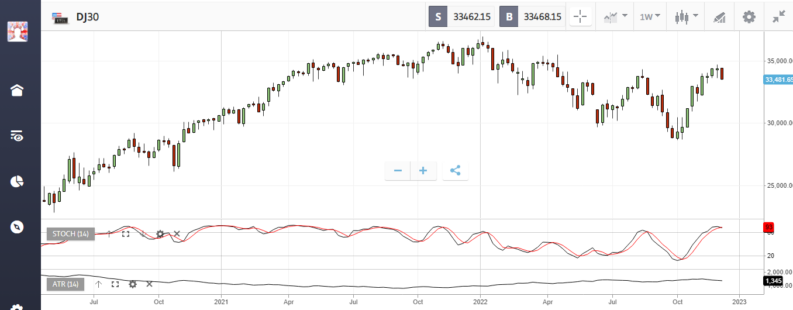
2022 has not been a good year for stocks in general. Even Blue Chips have fallen over 30% on average for the year to date, but there has been a recent rally in the final quarter of the year. For this reason, investors are beginning to plan their strategies for 2023, which would include selecting a few Blue Chips to complement their portfolios. Read on as we explore further.
Table of contents
- ARE BLUE CHIP STOCKS SAFE?
- IS NOW THE TIME TO BUY BLUE CHIP STOCKS?
- BEST BLUE CHIP STOCKS TO BUY RIGHT NOW
- APPLE (NASDAQ:AAPL)
- AMERICAN EXPRESS (NYSE:AXP)
- JOHNSON & JOHNSON (NYSE:JNJ)
- BEST HIGH DIVIDEND BLUE CHIP STOCKS
- COCA-COLA (NYSE:KO)
- MICROSOFT CORPORATION (NASDAQ:MSFT)
- NIKE, INC. (NYSE: NKE)
- WHY INVEST IN BLUE CHIP COMPANIES?
- WHAT TO KNOW BEFORE INVESTING IN BLUE CHIP COMPANIES
- FINAL THOUGHTS
ARE BLUE CHIP STOCKS SAFE?
Most investors regard Blue Chip stocks as belonging to a special club of the best, being held to higher standards, and representing the safest path to investment success. Are Blue Chips the safest stocks around? Safety at times is in the eye of the beholder, depending upon what relative criteria are being used.
Safety can mean different things to different investors. As Blue Chip companies are typically large, household names, the idea that you could lose heavily when investing in one is not a notion that many people share. Blue Chips, however, are not immune to economic swings or specific downturns within an industry type. These stocks can react negatively to an economic shock, the COVID-19 pandemic being a recent example.
The good thing about a Blue Chip security, however, is that it will more than likely bounce back more quickly when a recovery begins to take place. In bad times, a large market capitalisation in excess of $100bn and a strong balance sheet will act as buffers when turmoil in the market becomes a reality. These companies also benefit from large liquidity pools, thereby preventing too much of a bad reaction. Dips are always a good time to invest in these shares.
No Blue Chip companies, however, are immune to financial difficulties. The last financial crisis of nearly 15 years ago demonstrated that some Blue Chip businesses can go bankrupt – such as General Motors and Lehman Brothers, each considered historical powerhouses of value and safe-haven investments. The simple lesson is that all investments contain a degree of risk. Even Blue Chip firms come and go, drop out of favour, and are replaced.
IS NOW THE TIME TO BUY BLUE CHIP STOCKS?
This year has not been safe for both large and small companies, but is now the time to invest in Blue Chip stocks? Based on the Dow Jones chart presented above, this popular market index is down roughly 10% for the year after a slight rally over the past few months. One thing about Blue Chip stocks is that quality will shine through in the end. When the economy regains its strength, these companies tend to recover more quickly than others.
While some investors might want to avoid the market after suffering significant losses during the first half of 2022, there are many contrarians who view the current state of Blue Chips as an excellent opportunity to invest in high-quality businesses for the long term. Even with that being said, however, investors should still be selective in choosing those firms with the best chance of outperforming the market on a whole, as well as other Blue Chip offerings.
BEST BLUE CHIP STOCKS TO BUY RIGHT NOW
APPLE (NASDAQ:AAPL)
Apple is an enormous technology company that all investors are certain to be familiar with. Its iPhone is the most widely used phone worldwide, while it also produces Mac computers, iPads and Apple Watch devices. The company also has other offerings such as Apple Music, Apple TV, iTunes and its App Store, which provide it with recurring revenue streams. Apple has a strong base of loyal consumers who jump at the chance to purchase new products when they are released.
Apple has a market cap that hit the $1tn mark in 2018, soared over $2tn in 2020, and briefly climbed above $3tn in 2022. It has since pulled back, as have almost all other companies, but it remains the largest publicly traded firm. Observers also note that it is still growing. Its shares are currently valued at $142.16. Investors looking for income will also approve of Apple’s dividend payouts, which typically happen four times per year, with its current dividend yield at 0.62%.
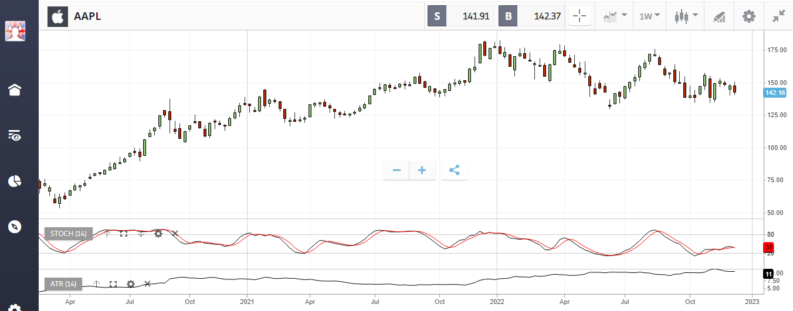
YOUR CAPITAL IS AT RISK. 76% OF RETAIL CFD ACCOUNTS LOSE MONEY.
APPL share prices have followed a similar trend, as with the DJIA, but its year-to-date loss is near to 20%. Despite its detractors, Apple has a way of leading the market, and, as is often said with high-quality companies, buy on the dips.
AMERICAN EXPRESS (NYSE:AXP)
American Express is a financial giant in the Blue Chip arena. It has been around in excess of 170 years, but it continues to reinvent itself and attract young consumers into its fold. It is well known as a credit card company, but it also owns and maintains its own proprietary payment network. AXP, along with its direct competitors, Visa and Mastercard, tend to pull back when the global economy weakens, but they are also harbingers of when the good times are just around the corner.
As interest rates rise and the economy improves, Amex will benefit from growing revenue streams from both ordinary payment transactions and extending credit to its customers. Its chart is not too dissimilar to the one for Apple.
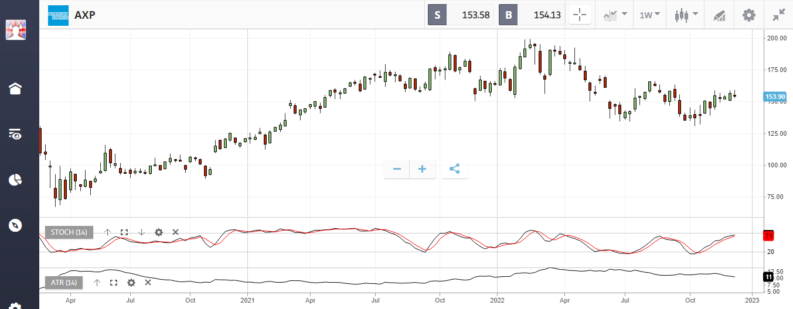
The forecast for AXP is for revenues to grow at a double-digit pace going forward, and dividends have already been raised during the current year.
JOHNSON & JOHNSON (NYSE:JNJ)
Johnson & Johnson has a variety of consumer products under its banner, including Neutrogena, Band-Aid, Johnson’s Baby Powder and Tylenol.
However, the majority of the company’s revenue comes from prescription drugs and medical devices. The company is an enormous pharmaceutical business, and it is currently one of several companies working on coronavirus vaccines. This giant in the healthcare business has already announced plans to divide into two separate companies in November 2023, splitting apart the consumer products component from the pharmaceutical and medical devices division.
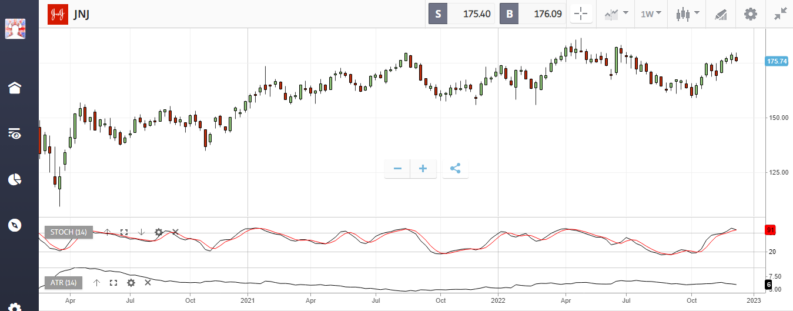
Johnson & Johnson’s share price is currently $175.74, with a market cap of $459.47bn and a dividend yield of 2.57%. The stability of consumer and healthcare products through the COVID-19 pandemic has been remarkable, as depicted above.
BEST HIGH DIVIDEND BLUE CHIP STOCKS
COCA-COLA (NYSE:KO)
Probably the most recognisable brand in the world, the beverage company engages in manufacturing, marketing, and the sale of non-alcoholic drinks. Some of its brands include Coca-Cola, Diet Coke, Fanta, Sprite, Powerade and Schweppes.
The company is a leader in its industry and has navigated through market changes over the years without hassle. It has proven over the past century that it can adapt to consumer tastes and market changes by expanding its global array of consumable products into every market across the planet.
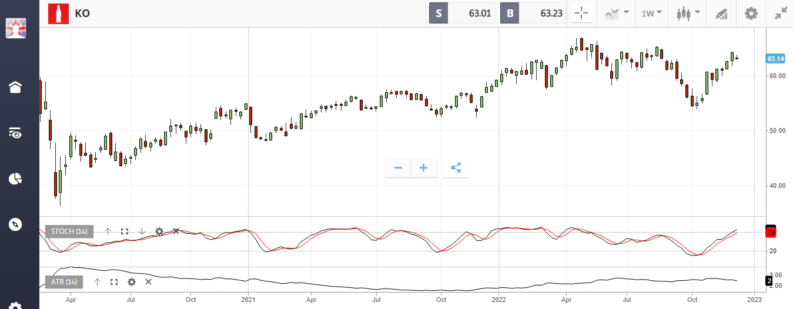
YOUR CAPITAL IS AT RISK. 76% OF RETAIL CFD ACCOUNTS LOSE MONEY.
Coca-Cola has been paying a dividend since the 1960s, a streak extremely admired by the investment community. Its current dividend yield is 2.79%, making it worthy of its place on the list. Like JNJ, it has performed admirably during the COVID-19 crisis.
MICROSOFT CORPORATION (NASDAQ:MSFT)
Microsoft is another household name and remains one of the leading distributors and providers of IT services in the world of high tech. The market has treated this stock harshly during the pandemic, but it has continued to perform, the target of many investors and hedge funds.
Revenues continue to grow and beat Street estimates, making MSFT an obvious ‘Buy’ due to it being undervalued at this moment in time. One respected analyst has already assigned a price target of $310, while its current shares are selling for $245.42.
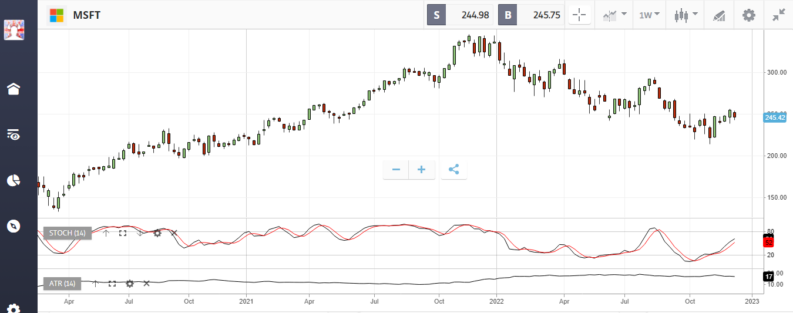
The firm also recently raised its dividend by 10%, thereby marking 16 years of consecutive growth in its dividend payouts. Long gone are the early years of MSFT when no dividends were paid. Its dividend yield now sits at 1.12%.
NIKE, INC. (NYSE: NKE)
A major manufacturer of shoes, related apparel and accessories, Nike is a giant in the consumer business. However, it has not fared as well as Microsoft, declining nearly 40% from its peak in late 2022. It has recently been beaten down due to revisions in guidance and profit projections.
Many hedge funds have exited, but quality firms such as this one tend to recover when the economy picks up. Several analysts have already rated the company as ‘Outperform’ and a good prospect for long-term investment. ‘Buy on the dips’ may be the message.
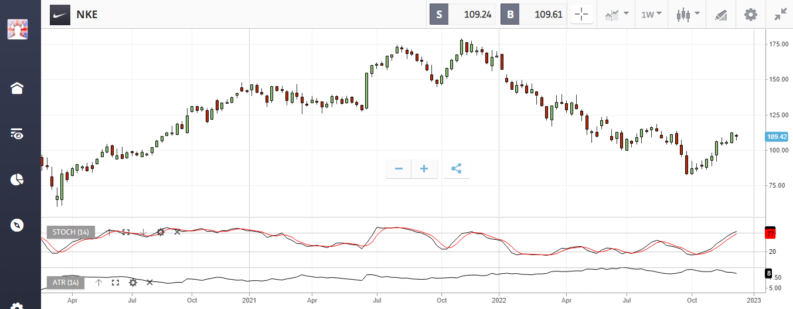
Buying a Blue Chip stock is certainly a prospect for those traders wishing to engage in a long-term strategy. In the case of Nike, after the tumultuous COVID-19 period, further patience may be required, but this is certainly a stock that is poised to perform for those with patience.
YOUR CAPITAL IS AT RISK. 76% OF RETAIL CFD ACCOUNTS LOSE MONEY.
WHY INVEST IN BLUE CHIP COMPANIES?
Blue Chip companies are seen as stable and are generally viewed as safe assets to invest in. They tend to have a good cash flow, and if we see a market crash, they are usually among the companies to make a healthy recovery.
The average rate of return for Blue Chip stocks is around 10%, meaning that they are smart investments, regardless of whether you are an experienced or inexperienced investor. Knowing that the company has been able to navigate through challenging periods and still come out as one of the leading players within its industry is reassuring. They also typically pay a consistent dividend.
WHAT TO KNOW BEFORE INVESTING IN BLUE CHIP COMPANIES
Even though the company you are investing in is a Blue Chip one, you still need to do your research and understand what it does so that you can make an informed investment decision.
Also, remember that while Blue Chip companies are considered safer investments, it does not mean that they won’t experience negative periods. However, if they or the market overall see a downturn, the Blue Chip company is likely to bounce back quicker.
Even if you are an experienced investor, you can still benefit from having one or a few Blue Chip stocks in your portfolio.
FINAL THOUGHTS
Investing is never easy, but the most important thing to do is to get started. From there, you can begin to learn and understand the mechanics of what goes into making a profitable investment decision.
Investing in Blue Chip stocks is a great place to start, as you can be confident in the stability of the company, while hopefully profiting from its dividend payments over time. However, before you begin, make sure that you understand the risks involved in your investments and try to reduce those risks where possible. A key means of achieving this is to invest with one of AskTraders’ recommended top brokers.
PEOPLE WHO READ THIS ALSO VIEWED:









